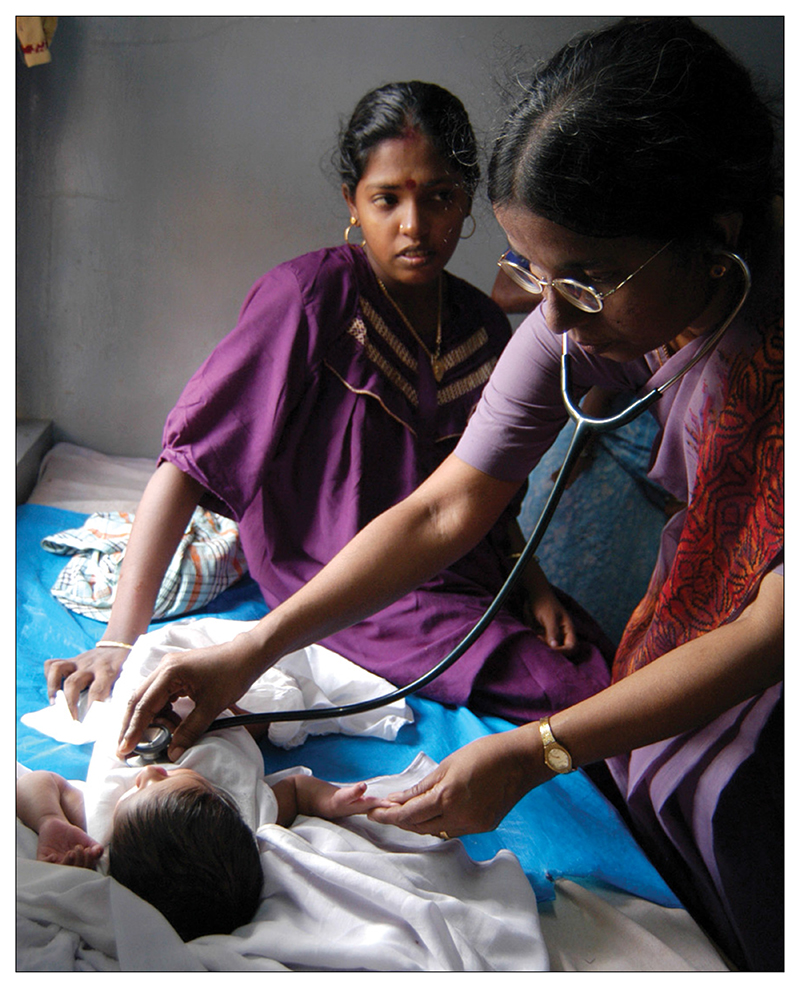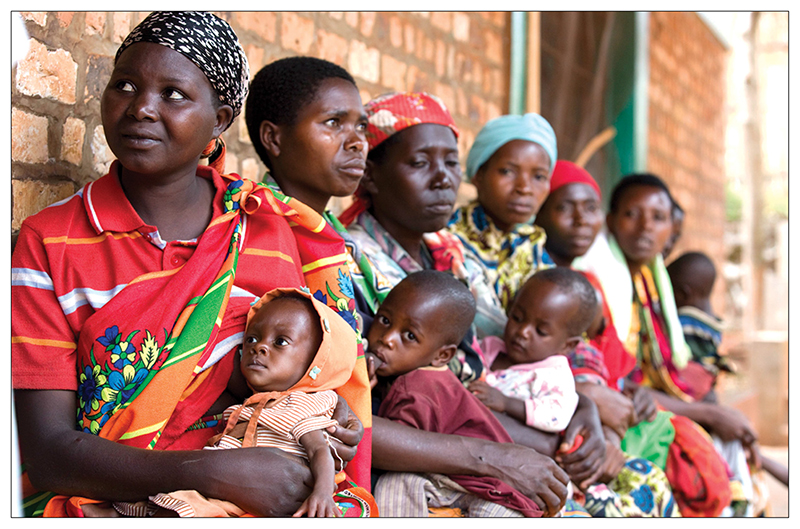Immunisation is one of the great global health successes of the past century, with millions of lives saved.1 Ensuring vaccination of millions of children is complex, but is made possible by one fundamental task: systematic counting at multiple levels and at frequent intervals. From charts in thousands of rural health posts, to databases in ministries of health, to standardised surveys and global reports from WHO, UNICEF, and GAVI, the Vaccine Alliance, a robust interconnected system of data collection and use enables health workers, programme managers, and global actors to track who is vaccinated and make course corrections as needed to improve performance, policies, and programmes.
Similar large-scale and long-term gains have been made against malaria by way of highly aligned and coordinated global measurement strategies linked to programmes.2 These characteristics were also a prominent feature of the successful global diarrhoeal disease control programme of the 1980s and early 1990s.3 “The Three Ones” (ie, one action framework, one national coordinating authority, and one country-level monitoring and evaluation system) for HIV promoted harmonised measurement plans that were made possible by an aggressive global capacity-building effort.4 In maternal, newborn, and child health, the counting is more difficult than in some other parts of global health, but has never been more crucial. The Sustainable Development Goals (SDGs) call for major reductions in maternal, neonatal, and child mortality and universal access to sexual and reproductive health services by 2030.5 These aims require further expansion in coverage, quality, and measurement of effective interventions.
Although the Millennium Development Goals (MDGs) sparked an increase in data collection,6 most countries still do not have timely data about how many of the women, adolescents, children, and newborns who need effective interventions are receiving them. This is unacceptable, and the global health community can do better. Great progress has been made through household survey programmes such as Demographic and Health Surveys and the Multiple Indicator Cluster Surveys, the Countdown to 2015 for Maternal, Newborn and Child Survival (Countdown) effort, and the investment and visibility promoted by the Commission on Information and Accountability for Women’s and Children’s Health and its independent Expert Review Group. Yet challenges remain, such as the need for improved standardised data collection and use at the facility level and innovation to address fundamental technical issues. A more robust data system to measure the coverage of interventions known to be effective in reducing maternal, newborn, and child mortality—similar to those that currently exist for vaccines and malaria—will be essential to enhance services, improve health, and achieve long-term goals in mortality reduction. Building on, extending, and refining this system for measuring maternal, newborn, and child health is an urgent task for the global community, as well as national and local governments. We envision a measurement system based on several key principles.
First, focus is needed to define a core set of global indicators of effective coverage for maternal, new-born, and child health interventions, with targets and measurement methods that can be tailored to local settings. Provision of quality care to mothers, neonates, and children requires a complex set of interventions and actions.7 Attempts have been made to prioritise which of these interventions can be measured and how.8 However, the absence of consensus and standards has been a barrier to global, country, and local actors working together to improve performance through reporting that enables comparisons both within and across countries. What is needed is a core set of coverage indicators (ie, about 15) that are informative, feasible, and cost effective to collect, to continue the work of Countdown and the independent Expert Review Group of the Commission on Information and Accountability for Women’s and Children’s Health. Each indicator must be accompanied by standard measurement methods, and the whole package should be agreed on by global normative agencies including the UN, major donors, and national governments.
Measures of process and quality should also be prioritised. Technical experts should be engaged to ensure accuracy is sufficient to not only produce comparable results but also to support sound policies and programme action. A global set of reference materials can be developed with full participation of government and technical leaders at country level. Baseline coverage levels need to be measured for each core indicator. National technical and political leaders need to define numerical targets for coverage up to 2030 and to implement processes to collect, report on, and make use of coverage data as they are collected. Throughout this effort to align global priorities, the global community will need to distinguish between indicators that can be measured adequately now, and aspirational indicators that could be measured after improved methods have been tested and integrated into national systems.
Second, relevance must be maintained to ensure that data about maternal, newborn, and child health coverage are useful in the country in which they are collected. National governments need to take the lead in resourcing and managing this data collection, analysis, and quality assurance—including both the core coverage indicators and additional relevant measures at the management level—and harmonisation of different types of routine reporting and surveys. Measurement expertise needs to be built at local, national, and regional levels so that learning, course correction, and data-driven policies and programmes are ensured. In these efforts to build local capacity, the global community must provide thoughtful assessments of what is needed to develop an adequate programme for the measurement and use of data about maternal, newborn, and child health. This contribution should include costed plans to allocate sufficient resources in a coordinated way—for training, but also to incentivise data analysis and use of results in both service delivery and management settings. Investments in national data for use in the context of programmes and service delivery need to be balanced with those for global comparisons and tracking.
Third, innovation will be crucial to develop efficient and technically sound methods and instruments to collect and make use of coverage data, including data about service quality. Priority must be given to the important barriers and challenges to effective measurement of coverage that exist in maternal, newborn, and child health. Observation of clinical actions as a basis for quality monitoring is time-consuming and expensive. However, asking women in household survey interviews to recall clinical actions that occurred around the time of births up to 2 years in the past can yield inaccurate information.9 Medium-term and long-term investments can be made to overcome these barriers, including optimisation of existing approaches and development of new technologies, such as biomarkers and mobile phone applications, which can generate accurate real-time data at regular intervals. However, collection and use of coverage data need to be improved now, even in the absence of these enabling tools and technologies. Immediate improvements are possible through linkage of household surveys with facility service assessments to produce proxy measures for effective coverage, and by use of composite measures to assess continuity and equity across the continuum of care. Results generated by research on implementation merit attention and further integration with the measurement agenda.
Fourth, equity as a fundamental component of programme design, measurement, and management is essential to direct resources to those most in need and at highest risk of death. To understand inequalities and focus programme resources on bridging gaps in coverage, data about coverage and outcomes are needed for subpopulations disaggregated by subnational geographies, wealth quintiles, gender, urban or rural residence, access to health services, and other determinants. Making equity central to the design of all measurement and evaluation plans for maternal, newborn, and child health will strengthen programme implementation.10
Finally, leadership is needed to prioritise measurement and evaluation within the global strategic agenda for reproductive, maternal, newborn, child, and adolescent health (RMNCAH), increasing the attention and investment given to data collection and use. Improved coordination and integration of measurement agendas is needed urgently, not only for measurement and evaluation plans, but also across the broader continuum of RMNCAH. All global activities, including major funding initiatives such as the Global Financing Facility for Every Woman, Every Child,11 need a common measurement framework, shared priorities, and dedicated resources to support action and adaptation to specific national and subnational contexts. The RMNCAH content must also link to broader harmonisation initiatives, such as the Roadmap for Health Measurement and Accountability.12 New mechanisms must be put in place to allow technical experts to develop, disseminate, implement, and report on a global RMNCAH measurement agenda and to manage global measurement priorities. We call on governments, partners, and technical experts to join in the movement for improved measurement for maternal, newborn, and child health, building on what is known and endorsing an urgent, evidence-based agenda for action and development to do better in the immediate future.
Footnotes
We declare no competing interests. The Kirkland Group (which met at Kirkland, WA, USA, in May, 2015) comprises Agbessi Amouzou, Anshu Banerjee, James Blanchard, Ties Boerma, Jennifer Bryce, Mariam Claeson, Shams El Arifeen, Suzanne Fournier, Catherine Goode, John Grove, Tanya Guenther, Katherine Hay, Carol Levin, Tanya Marchant, Elizabeth Mason, Allisyn Moran, Assaye Nigussie, Jennifer Requejo, Maria Clara Restrepo, Katherine Semrau, Kate Somers, Cesar Victora, Peter Waiswa, and Neff Walker. We thank Clint Nohavec, Vanessa Laughlin, Benjamin Jenson, and Kaci Kennedy for their help in preparing this Comment.
References
- 1.GAVI, the Vaccine Alliance. Every child counts: saving children’s lives and protecting people’s health by increasing access to immunisation in poor countries. Annual progress report for 2011-2015. GAVI Alliance; Geneva: 2015. [accessed Sept 16, 2015]. http://gaviprogressreport.org/2014/ [Google Scholar]
- 2.WHO. World malaria report 2014. World Health Organization; Geneva: 2014. [accessed Sept 16, 2015]. http://who.int/malaria/publications/world_malaria_report_2014/report/en/ [Google Scholar]
- 3.Claeson M, Merson MH. Global progress in the control of diarrheal diseases. Pediatr Infect Dis J. 1990;9:345–55. doi: 10.1097/00006454-199005000-00008. [DOI] [PubMed] [Google Scholar]
- 4.UNAIDS. “Three Ones” key principles. Coordination of national responses to HIV/AIDS: guiding principles for national authorities and their partners. 2004. [accessed Sept 16, 2015]. http://data.unaids.org/UNA-docs/three-ones_keyprinciples_en.pdf .
- 5.United Nations. 2015—time for global action for people and planet. United Nations; New York: 2015. [accessed Sept 16, 2015]. http://www.un.org/sustainabledevelopment . [Google Scholar]
- 6.UN System Task Team on the Post-2015 UN Development Agenda. Statistics and indicators for the post-2015 development agenda. United Nations; New York: 2013. [accessed Sept 16, 2015]. http://www.un.org/en/development/desa/policy/untaskteam_undf/UNTT_MonitoringReport_WEB.pdf . [Google Scholar]
- 7.Kerber KJ, de Graft-Johnson JE, Bhutta ZA, Okong P, Starrs A, Lawn JE. Continuum of care for maternal, newborn, and child health: from slogan to service delivery. Lancet. 2007;370:1358–69. doi: 10.1016/S0140-6736(07)61578-5. [DOI] [PubMed] [Google Scholar]
- 8.Requejo JH, Newby H, Bryce J. Measuring coverage in MNCH: challenges and opportunities in the selection of coverage indicators for global monitoring. PLoS Med. 2013;10:e1001416. doi: 10.1371/journal.pmed.1001416. [DOI] [PMC free article] [PubMed] [Google Scholar]
- 9.Bryce J, Arnold F, Hancioglu A, et al. the CHERG working group on improving coverage measurement. Measuring coverage in maternal, newborn and child health: new findings, new strategies and recommendations for action. PLoS Med. 2013;10:e1001423. doi: 10.1371/journal.pmed.1001423. [DOI] [PMC free article] [PubMed] [Google Scholar]
- 10.Barros AJD, Victora CG. Measuring coverage in MNCH: determining and interpreting inequalities in coverage of maternal, newborn, and child health interventions. PLoS Med. 2013;10:e1001390. doi: 10.1371/journal.pmed.1001390. [DOI] [PMC free article] [PubMed] [Google Scholar]
- 11.World Bank. Concept note: a global financing facility in support of every woman, every child. World Bank; Washington, DC: 2014. [accessed Sept 16, 2015]. http://www.worldbank.org/content/dam/Worldbank/document/HDN/Health/ConceptNote-AGlobalFinancingFacilitySupportEveryWomanEveryChild.pdf . [Google Scholar]
- 12.Common Road Map Steering Committee. The roadmap for health measurement and accountability. MA4Health; Washington, DC: 2015. [accessed Sept 16, 2015]. https://www.usaid.gov/sites/default/files/documents/1864/roadmap_6-4-15_web.pdf . [Google Scholar]




